Unit 2 Ways to go to school 单元复习课件(共83张PPT)
文档属性
| 名称 | Unit 2 Ways to go to school 单元复习课件(共83张PPT) | 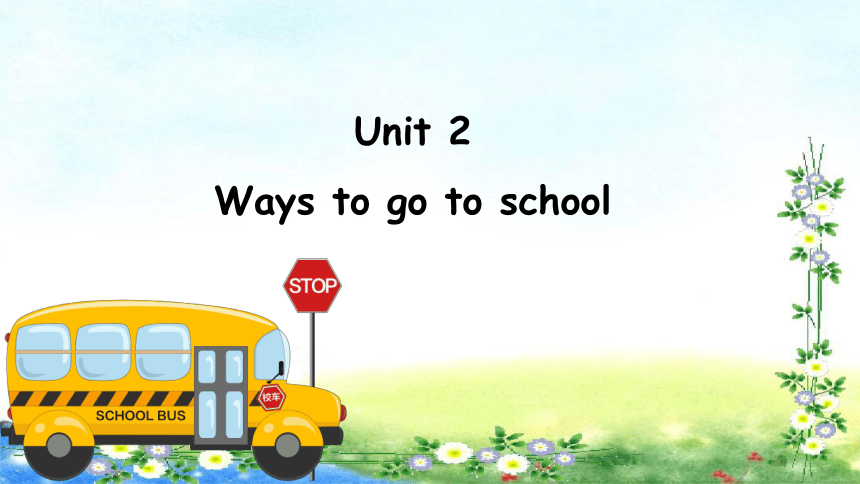 | |
| 格式 | pptx | ||
| 文件大小 | 25.6MB | ||
| 资源类型 | 教案 | ||
| 版本资源 | 人教版(PEP) | ||
| 科目 | 英语 | ||
| 更新时间 | 2021-08-19 15:14:31 | ||
图片预览

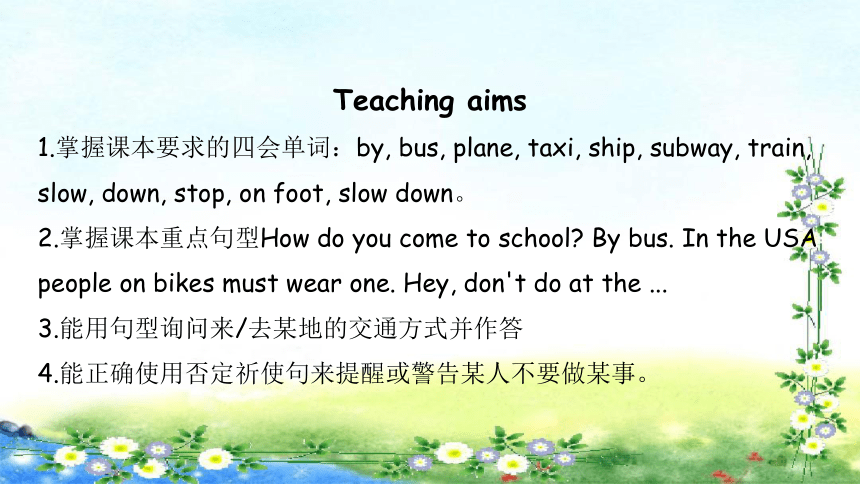

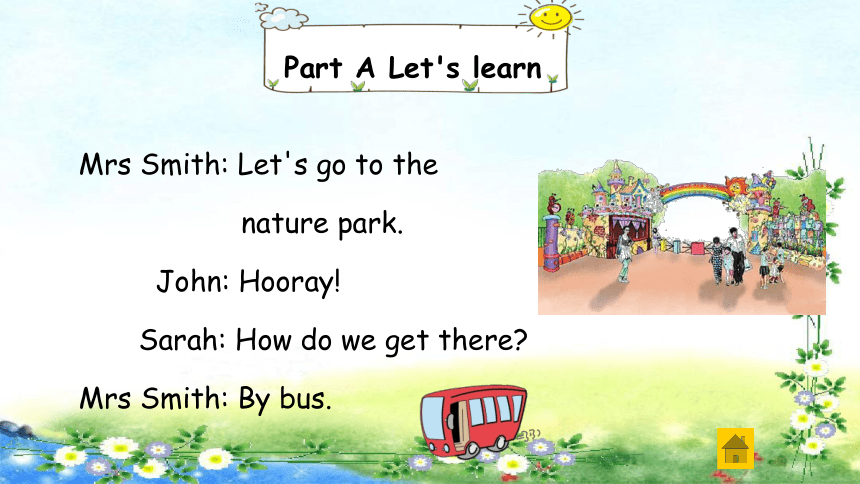
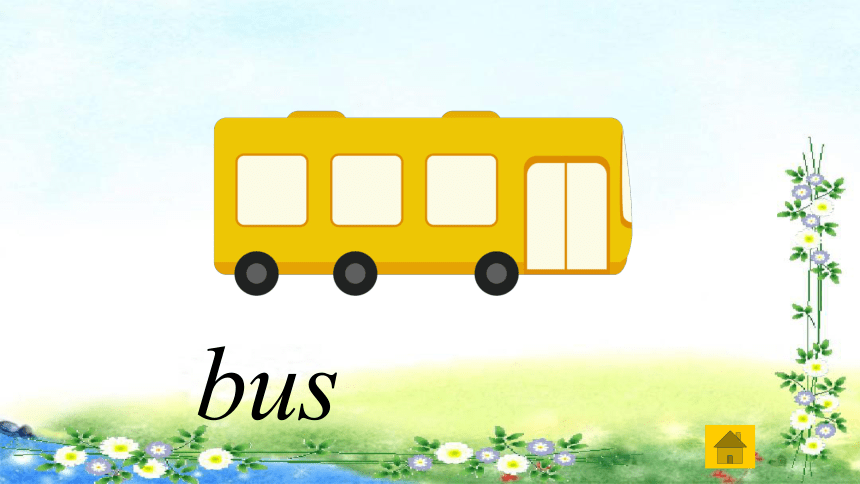

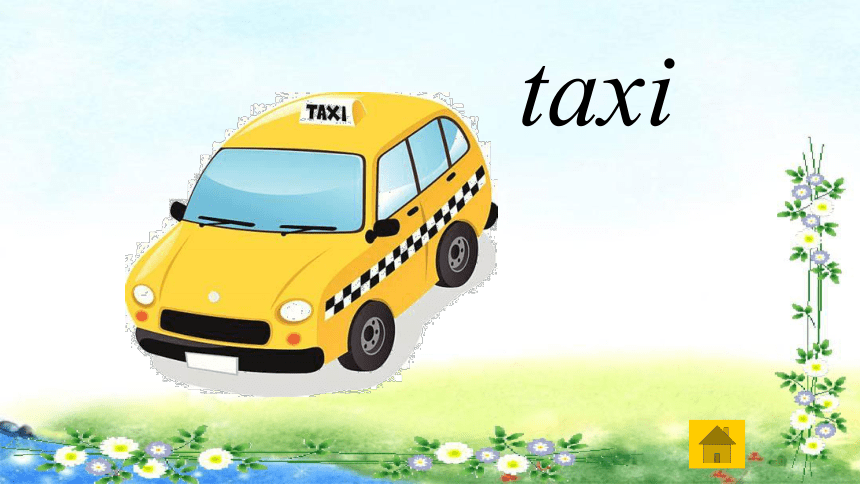
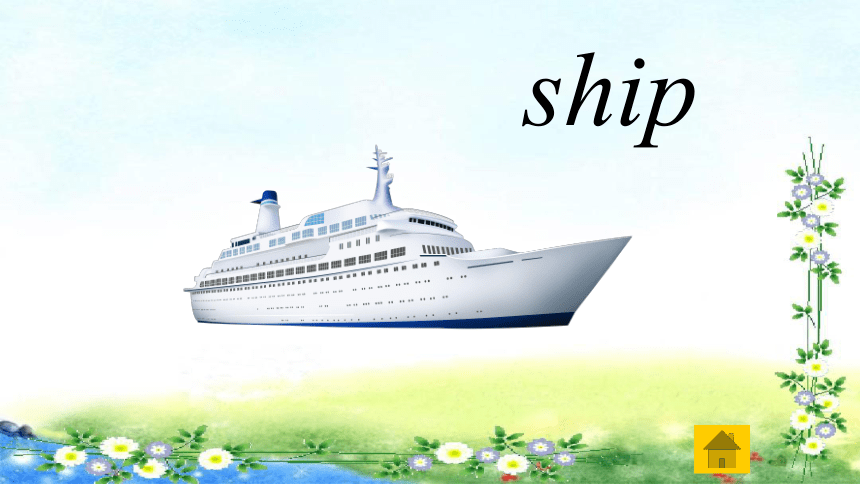
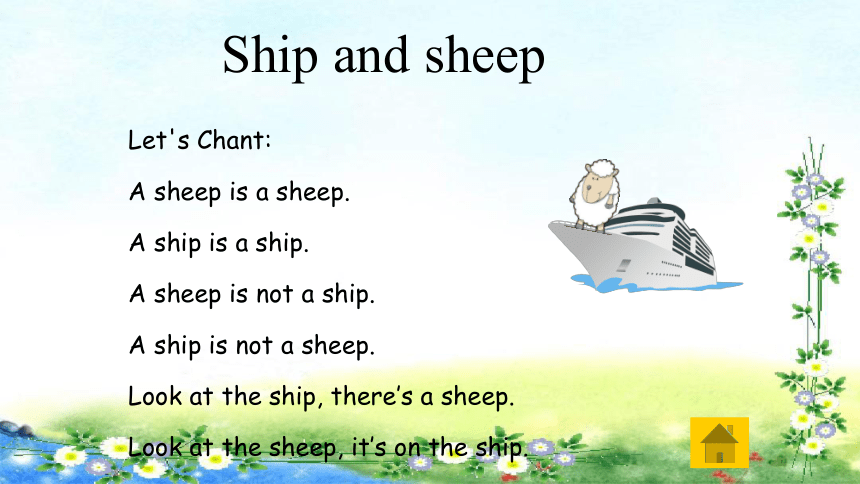
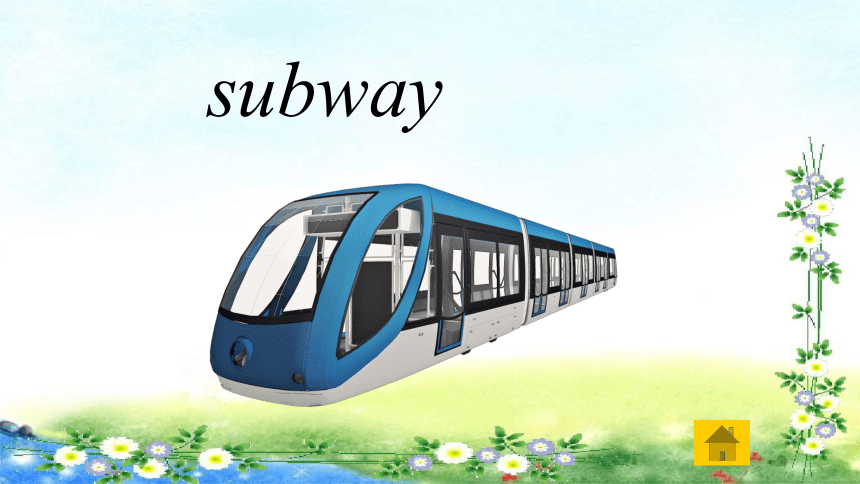
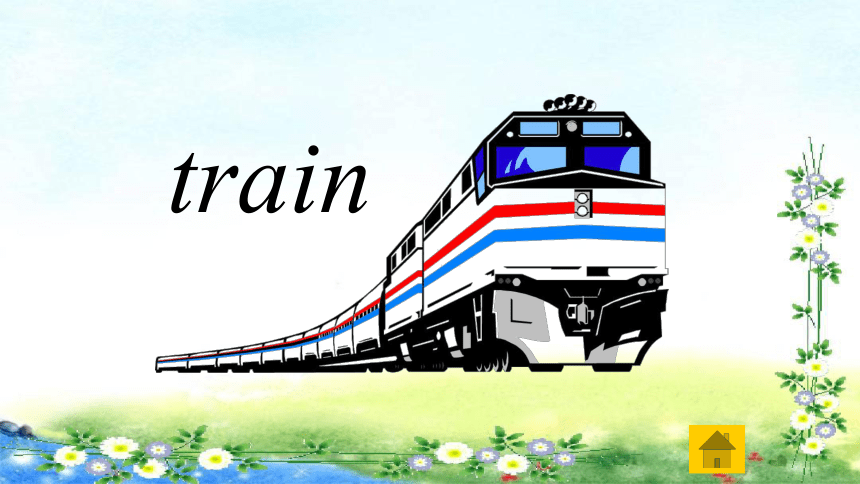

文档简介
(共83张PPT)
Unit
2
Ways
to
go
to
school
Teaching
aims
1.掌握课本要求的四会单词:by,
bus,
plane,
taxi,
ship,
subway,
train,
slow,
down,
stop,
on
foot,
slow
down。
2.掌握课本重点句型How
do
you
come
to
school?
By
bus.
In
the
USA
people
on
bikes
must
wear
one.
Hey,
don't
do
at
the
...
3.能用句型询问来/去某地的交通方式并作答
4.能正确使用否定祈使句来提醒或警告某人不要做某事。
目
录
Part
A
Let's
learn
Write
and
say
Let's
try
Let's
talk
Part
B
Let's
learn
Role-play
Let's
try
Let's
talk
Read
and
write
Tips
for
pronunciation
Let's
check
Let's
wrap
it
up
Story
time
单元小结
重点词汇
重点句型
小练习
欢乐记单词
轻松学语法
Mrs
Smith:
Let's
go
to
the
nature
park.
John:
Hooray!
Sarah:
How
do
we
get
there?
Mrs
Smith:
By
bus.
Part
A
Let's
learn
bus
plane
taxi
ship
Let's
Chant:
A
sheep
is
a
sheep.
A
ship
is
a
ship.
A
sheep
is
not
a
ship.
A
ship
is
not
a
sheep.
Look
at
the
ship,
there’s
a
sheep.
Look
at
the
sheep,
it’s
on
the
ship.
Ship
and
sheep
subway
train
train
ai
/ei/
train
wait
rain
painting
train
subway
地铁通常是地下的,而火车是在地面上的、户外的。
car
Guess:
What's
this?
bus
I
am
a
bird
.
I
can
fly.
I’m
big
and
hard.
I
don’t
eat.
What
am
I?
猜猜我是谁?
plane
I
live
on
the
sea.
I
can
swim
very
fast.
But
I’m
not
a
fish.
I’m
a
traffic
tool.
What
am
I?
猜猜我是谁?
ship
I'm
a
kind
of(一种)
train.
I
work
under
the
ground.
I
run
fast.
What
am
I?
猜猜我是谁?
by
bus
by
plane
by
taxi
by
bike
by
car
by
train
by
subway
by+交通工具:乘,坐
A.
I
go
to
school
on
foot.
B.
I
go
to
school
by
foot.
√
on
foot
×
by
ship
taxi
bus
train
plane
subway
on
foot
Part
A
Write
and
say
Part
A
Let's
try
Amy
meets
Mike
at
school
this
morning.
Listen
and
tick
or
cross.
1.(
)
They
are
talking
about
a
sports
meet.
2.(
)
They
will
go
by
bus.
√
×
Task
1:
Listen
and
repeat.
Mike:
Good
morning,
Mrs
Smith!
Mrs
Smith:
Hi,
children.
You’re
early.
How
do
you
come
to
school?
Amy:
Usually,
I
come
on
foot.
Sometimes
I
come
by
bus.
Part
A
Let's
talk
Task
1:
Listen
and
repeat.
Mike:
I
often
come
by
bike.
Amy:
How
do
you
come
to
school,
Mrs
Smith?
By
car?
Mrs
Smith:
Sometimes,
but
I
usually
walk.
Mike:
That’s
good
exercise.
Part
A
Let's
talk
—
How
do
you
come
to
school?
—
I
usually
/
often
/
sometimes
...
usually
通常
often
经常
sometimes
有时候
What
are
these?
guess
Part
B
Let's
learn
traffic
lights
red
light
yellow
light
green
light
What
do
they
mean?
Stop
and
wait
at
a
red
light.
Slow
down
and
stop
at
a
yellow
light.
Go
at
a
green
light.
traffic
rules
交通规则
green
light
Go
at
a
green
light.
red
light
Stop
and
wait
at
a
red
light.
Don't
go
at
a
red
light.
You
must
stop
and
wait.
yellow
light
Slow
down
and
stop
at
a
yellow
light.
Don’t
go
at
a
yellow
light.
You
must
slow
down
and
stop.
traffic
rules(规则)
traffic
lights
Remember
the
traffic
rules.
Look
at
the
traffic
lights.
red
light
yellow
light
green
light
Go
at
a
green
light.
Stop
and
wait
at
a
red
light.
Slow
down
and
stop
at
a
yellow
light.
Remember(记住)
the
traffic
rules.
the
traffic
rules.
at
the
traffic
lights.
at
a
yellow
light.
at
a
green
light.
at
a
red
light.
1.
Look
5.
Remember
3.
Stop
and
wait
4.
Slow
down
and
stop
2.
Go
请你连一连
Part
B
Role
play
What
does
Mrs
Smith
tell
the
children
to
do?
Part
B
Let's
try
helmet
traffic
lights
Part
B
Let's
talk
Wu
Yifan:
Mr
Jones,
how
can
I
get
to
the
Fuxing
Hospital?
Mr
Jones:
Take
the
No.
57
bus
over
there.
Wu
Yifan:
Thanks.
Wow!
So
many
pictures
of
bikes!
Mr
Jones:
They’re
from
my
cousin
in
the
USA.
Wu
Yifan:
What’s
this?
Part
B
Let's
talk
Part
B
Let's
talk
Mr
Jones:
A
helmet.
In
the
USA
people
on
bikes
must
wear
one.
Wu
Yifan:
I
see.
Oh,
the
bus
is
coming!
Bye,
Mr
Jones.
Mr
Jones:
Hey,
don’t
go
at
the
red
light!
Wu
Yifan:
Oh,
right!
Thanks.
I
must
pay
attention
to
the
traffic
lights!
We
must
pay
attention
to
the
traffic
lights.
We
must
wear
the
helmet
on
the
bikes.
What
do
you
learn
about
riding
a
bike
from
the
dialogue?
1.
_____
can
I
____
____
the
Fuxing
Hospital?
2._______
the
No.57
bus
_______
there.
3.So
many
pictures
____
bikes!
4.They
_____
______
my
cousin
____
the
USA.
How
get
to
Take
over
of
are
from
in
读课文,填空。
5.What
____
this?
6.In
the
USA
people
____
bikes
must
wear
one.
7.The
bus
is
_________.
8.______
go
____
the
red
light!
9.I
must
______________
the
traffic
lights!
is
on
coming
Don't
at
pay
attention
to
You
must
look
right
before
you
cross
the
road.
You
can
see
this
on
the
road
in
Hong
Kong.
It
means
“stop”.
Don’t
turn
right.
Don’t
turn
left.
Don’t
touch
the
door.
You
can
see
this
in
the
subway.
.
turn
right
crosswalk
no
cars
no
parking
no
bikes
go
straight
turn
left
Traffic
Signs
sled
Read
and
write
ferry
Some
children
go
to
school
on
foot
in
Munich,
Germany.
Let's
listen,
repeat
and
read.
Task
2:
Read
and
circle
the
ways
to
go
to
school.
In
Papa
Westray,
Scotland,
the
children
go
to
school
by
ferry,
too.
But
in
2009,
they
went
to
school
by
plane
because
the
ferry
didn’t
work.
In
Alaska,
USA,
it
snows
a
lot.
Some
kids
go
to
school
by
sled.
It’s
fast.
Some
children
in
Jiangxi,
China,
go
to
school
by
ferry
every
day.
1.How
many
ways
to
go
to
school
can
you
find
in
the
text?
Underline
them.
2.Does
everyone
in
the
text
go
to
school?
Read
the
text
and
answer
the
questions.
1.
How
many
ways
to
go
to
school
can
you
find
in
the
text?
Underline
them.
2.
Does
everyone
in
the
text
go
to
school?
Four.
On
foot/by
sled/by
ferry/by
plane.
No,
Robin
doesn’t
go
to
school.
Choose
some
suggestions
for
the
kids
on
page
18.
Tips
for
pronunciation
Listen,
look
and
say.
come
and
have
a
look
pictures
of
stop
at
a
red
light
3
2
4
1
Let's
check
Listen
and
number.
Listen
again
and
answer
the
questions.
How
does
Wu
Yifan
go
to
the
park?
He
goes
by
_______.
How
does
the
girl's
father
go
to
work?
He
goes
by
________.
How
does
Amy
go
home?
She
goes
_____
_____.
What
will
the
woman
do?
She
will
_____
and
_____.
bus
train
on
foot
stop
wait
Come
or
go?
Where
is
Mike?
Tick
or
cross.
Go
to
the
cinema.
At
the
cinema.
Not
at
the
cinema.
Let's
wrap
it
up
How
does
Mrs
Zhao
come
to
school?
At
school.
Not
at
school.
How
can
I
go
to
the
museum?
At
the
museum.
Not
at
the
museum.
Come
to
the
park
and
play
with
us.
In
the
park.
Not
in
the
park.
Story
time
点击画面
播放视频
单元小结
重点词汇
bus
plane
taxi
ship
subway
train
by
on
foot
stop
slow
down
slow
down
公共汽车
飞机
出租汽车
(大)船
地铁
火车
(表示方式)乘
步行
停下
慢的
减少;降低
慢下来
重点句型
1.How
do
you
get
to...?
你怎么去……?
2.I
usually/often/sometimes
come
to
school
on
foot/by...
我通常/经常/有时候步行/乘……来学校。
3.Don't
go
at
the
red
light!
别闯红灯!
4.I
must
pay
attention
to
the
traffic
lights!
我必须注意交通信号灯!
(
)1.Don’t
go
_____
the
red
light!
A.by
B.
at
C.on
(
)2.Please
pay
attention
_____
the
traffic
lights.
A.on
B.
to
C.at
(
)3.The
yellow
light
means
‘‘
______’’.
A.go
B.stop
C.wait
B
B
C
一、开心三选一。
小练习
(
)4._______
can
I
get
to
the
zoo?
A.What
B.How
C.How
old
(
)5.How
______
Lily
go
to
school?
A.do
B.is
C.does
B
C
一、开心三选一。
小练习
二、连词成句。
1.
to
park
How
can
get
the
we
?
_____________________________________
2.
by
can
bus
You
No.
15
go
the
.
_____________________________________
3.
the
post
do
office
go
How
to
you
?
_____________________________________
4.
train
I
go
usually
by
.
_____________________________________
How
can
we
get
to
the
park?
You
can
go
by
the
No.
15
bus.
How
do
you
go
to
the
post
office?
I
usually
go
by
train.
欢乐记单词
现代社会发展快,交通工具也换代,
陆上穿行比较多,短程步行on
foot,
公交站里坐bus,紧急打车用taxi,
畅通无阻选subway,路途遥远乘train,
水上航行靠ship,空中飞行是plane,
便捷出行选择多,高新生活无限好。
日常交通很重要,交通规则需记牢;
红灯停(Stop
at
the
red
light),
绿灯行(Go
at
the
green
light),
黄灯亮了减速等一等
(Slow
down
and
stop
at
the
yellow
light)。
轻松学语法
语法一:询问出行方式
句型结构:How
do/does+主语+come/go
to+地点?
答语:
主语+come(s)/go(es)
to+地点+by+交通工具.
主语+come(s)/go(es)
to+地点+on
foot.
主语+take(s)
a+交通工具.
主语+take(s)
the
+车号+交通工具.
【小贴士】by后面一定要直接加交通工具的单数形式。另外,
“小脚丫”
foot与on搭配,即“步行”要用“on
foot”表示。
例:
语法二:频度副词
频度副词是用来表示动作频率的,但程度上有别。常用的频度副词频率由高到低用图表示为:
always
usually
often
sometimes
never
100%
80%
60%
40%
0%
语法二:频度副词
—When
do
you
get
up?
—I
usually
get
up
at
8:00.
Sometimes
Tom
goes
to
school
by
bike.
语法三:情态动词must
must是情态动词,意为“必须”,语气很强烈,没有人称和数的变化,后面接动词原形。
句型结构:
主语+must+动词原形+其他.
例:
—Mum,
can
I
watch
TV
now?
—Yes,
you
can.
But
you
must
do
your
homework
first.
语法四:祈使句
祈使句主要用来表达请求、命令、建议、叮嘱或祝愿等。
祈使句通常省略主语(you)。
■肯定祈使句
1.Do型祈使句
句型结构:动词原形+其他.
例:
2.Be型祈使句
句型结构:Be+形容词.
例:
Be
quiet!
Be
a
good
boy!
3.Let型祈使句
句型结构:Let's/Let
me+动词原形+其他.
例:
Let
me
help
you.
Let's
play
football.
■否定祈使句
1.Don't型祈使句
句型结构:Don't+动词原形+其他.
例:
Don‘t
swim
in
the
river.
2.No型祈使句
句型结构:
(1)No+动词-ing形式+其他.
(2)No+名词+其他.
例:
No
photos!
谢谢欣赏
Unit
2
Ways
to
go
to
school
Teaching
aims
1.掌握课本要求的四会单词:by,
bus,
plane,
taxi,
ship,
subway,
train,
slow,
down,
stop,
on
foot,
slow
down。
2.掌握课本重点句型How
do
you
come
to
school?
By
bus.
In
the
USA
people
on
bikes
must
wear
one.
Hey,
don't
do
at
the
...
3.能用句型询问来/去某地的交通方式并作答
4.能正确使用否定祈使句来提醒或警告某人不要做某事。
目
录
Part
A
Let's
learn
Write
and
say
Let's
try
Let's
talk
Part
B
Let's
learn
Role-play
Let's
try
Let's
talk
Read
and
write
Tips
for
pronunciation
Let's
check
Let's
wrap
it
up
Story
time
单元小结
重点词汇
重点句型
小练习
欢乐记单词
轻松学语法
Mrs
Smith:
Let's
go
to
the
nature
park.
John:
Hooray!
Sarah:
How
do
we
get
there?
Mrs
Smith:
By
bus.
Part
A
Let's
learn
bus
plane
taxi
ship
Let's
Chant:
A
sheep
is
a
sheep.
A
ship
is
a
ship.
A
sheep
is
not
a
ship.
A
ship
is
not
a
sheep.
Look
at
the
ship,
there’s
a
sheep.
Look
at
the
sheep,
it’s
on
the
ship.
Ship
and
sheep
subway
train
train
ai
/ei/
train
wait
rain
painting
train
subway
地铁通常是地下的,而火车是在地面上的、户外的。
car
Guess:
What's
this?
bus
I
am
a
bird
.
I
can
fly.
I’m
big
and
hard.
I
don’t
eat.
What
am
I?
猜猜我是谁?
plane
I
live
on
the
sea.
I
can
swim
very
fast.
But
I’m
not
a
fish.
I’m
a
traffic
tool.
What
am
I?
猜猜我是谁?
ship
I'm
a
kind
of(一种)
train.
I
work
under
the
ground.
I
run
fast.
What
am
I?
猜猜我是谁?
by
bus
by
plane
by
taxi
by
bike
by
car
by
train
by
subway
by+交通工具:乘,坐
A.
I
go
to
school
on
foot.
B.
I
go
to
school
by
foot.
√
on
foot
×
by
ship
taxi
bus
train
plane
subway
on
foot
Part
A
Write
and
say
Part
A
Let's
try
Amy
meets
Mike
at
school
this
morning.
Listen
and
tick
or
cross.
1.(
)
They
are
talking
about
a
sports
meet.
2.(
)
They
will
go
by
bus.
√
×
Task
1:
Listen
and
repeat.
Mike:
Good
morning,
Mrs
Smith!
Mrs
Smith:
Hi,
children.
You’re
early.
How
do
you
come
to
school?
Amy:
Usually,
I
come
on
foot.
Sometimes
I
come
by
bus.
Part
A
Let's
talk
Task
1:
Listen
and
repeat.
Mike:
I
often
come
by
bike.
Amy:
How
do
you
come
to
school,
Mrs
Smith?
By
car?
Mrs
Smith:
Sometimes,
but
I
usually
walk.
Mike:
That’s
good
exercise.
Part
A
Let's
talk
—
How
do
you
come
to
school?
—
I
usually
/
often
/
sometimes
...
usually
通常
often
经常
sometimes
有时候
What
are
these?
guess
Part
B
Let's
learn
traffic
lights
red
light
yellow
light
green
light
What
do
they
mean?
Stop
and
wait
at
a
red
light.
Slow
down
and
stop
at
a
yellow
light.
Go
at
a
green
light.
traffic
rules
交通规则
green
light
Go
at
a
green
light.
red
light
Stop
and
wait
at
a
red
light.
Don't
go
at
a
red
light.
You
must
stop
and
wait.
yellow
light
Slow
down
and
stop
at
a
yellow
light.
Don’t
go
at
a
yellow
light.
You
must
slow
down
and
stop.
traffic
rules(规则)
traffic
lights
Remember
the
traffic
rules.
Look
at
the
traffic
lights.
red
light
yellow
light
green
light
Go
at
a
green
light.
Stop
and
wait
at
a
red
light.
Slow
down
and
stop
at
a
yellow
light.
Remember(记住)
the
traffic
rules.
the
traffic
rules.
at
the
traffic
lights.
at
a
yellow
light.
at
a
green
light.
at
a
red
light.
1.
Look
5.
Remember
3.
Stop
and
wait
4.
Slow
down
and
stop
2.
Go
请你连一连
Part
B
Role
play
What
does
Mrs
Smith
tell
the
children
to
do?
Part
B
Let's
try
helmet
traffic
lights
Part
B
Let's
talk
Wu
Yifan:
Mr
Jones,
how
can
I
get
to
the
Fuxing
Hospital?
Mr
Jones:
Take
the
No.
57
bus
over
there.
Wu
Yifan:
Thanks.
Wow!
So
many
pictures
of
bikes!
Mr
Jones:
They’re
from
my
cousin
in
the
USA.
Wu
Yifan:
What’s
this?
Part
B
Let's
talk
Part
B
Let's
talk
Mr
Jones:
A
helmet.
In
the
USA
people
on
bikes
must
wear
one.
Wu
Yifan:
I
see.
Oh,
the
bus
is
coming!
Bye,
Mr
Jones.
Mr
Jones:
Hey,
don’t
go
at
the
red
light!
Wu
Yifan:
Oh,
right!
Thanks.
I
must
pay
attention
to
the
traffic
lights!
We
must
pay
attention
to
the
traffic
lights.
We
must
wear
the
helmet
on
the
bikes.
What
do
you
learn
about
riding
a
bike
from
the
dialogue?
1.
_____
can
I
____
____
the
Fuxing
Hospital?
2._______
the
No.57
bus
_______
there.
3.So
many
pictures
____
bikes!
4.They
_____
______
my
cousin
____
the
USA.
How
get
to
Take
over
of
are
from
in
读课文,填空。
5.What
____
this?
6.In
the
USA
people
____
bikes
must
wear
one.
7.The
bus
is
_________.
8.______
go
____
the
red
light!
9.I
must
______________
the
traffic
lights!
is
on
coming
Don't
at
pay
attention
to
You
must
look
right
before
you
cross
the
road.
You
can
see
this
on
the
road
in
Hong
Kong.
It
means
“stop”.
Don’t
turn
right.
Don’t
turn
left.
Don’t
touch
the
door.
You
can
see
this
in
the
subway.
.
turn
right
crosswalk
no
cars
no
parking
no
bikes
go
straight
turn
left
Traffic
Signs
sled
Read
and
write
ferry
Some
children
go
to
school
on
foot
in
Munich,
Germany.
Let's
listen,
repeat
and
read.
Task
2:
Read
and
circle
the
ways
to
go
to
school.
In
Papa
Westray,
Scotland,
the
children
go
to
school
by
ferry,
too.
But
in
2009,
they
went
to
school
by
plane
because
the
ferry
didn’t
work.
In
Alaska,
USA,
it
snows
a
lot.
Some
kids
go
to
school
by
sled.
It’s
fast.
Some
children
in
Jiangxi,
China,
go
to
school
by
ferry
every
day.
1.How
many
ways
to
go
to
school
can
you
find
in
the
text?
Underline
them.
2.Does
everyone
in
the
text
go
to
school?
Read
the
text
and
answer
the
questions.
1.
How
many
ways
to
go
to
school
can
you
find
in
the
text?
Underline
them.
2.
Does
everyone
in
the
text
go
to
school?
Four.
On
foot/by
sled/by
ferry/by
plane.
No,
Robin
doesn’t
go
to
school.
Choose
some
suggestions
for
the
kids
on
page
18.
Tips
for
pronunciation
Listen,
look
and
say.
come
and
have
a
look
pictures
of
stop
at
a
red
light
3
2
4
1
Let's
check
Listen
and
number.
Listen
again
and
answer
the
questions.
How
does
Wu
Yifan
go
to
the
park?
He
goes
by
_______.
How
does
the
girl's
father
go
to
work?
He
goes
by
________.
How
does
Amy
go
home?
She
goes
_____
_____.
What
will
the
woman
do?
She
will
_____
and
_____.
bus
train
on
foot
stop
wait
Come
or
go?
Where
is
Mike?
Tick
or
cross.
Go
to
the
cinema.
At
the
cinema.
Not
at
the
cinema.
Let's
wrap
it
up
How
does
Mrs
Zhao
come
to
school?
At
school.
Not
at
school.
How
can
I
go
to
the
museum?
At
the
museum.
Not
at
the
museum.
Come
to
the
park
and
play
with
us.
In
the
park.
Not
in
the
park.
Story
time
点击画面
播放视频
单元小结
重点词汇
bus
plane
taxi
ship
subway
train
by
on
foot
stop
slow
down
slow
down
公共汽车
飞机
出租汽车
(大)船
地铁
火车
(表示方式)乘
步行
停下
慢的
减少;降低
慢下来
重点句型
1.How
do
you
get
to...?
你怎么去……?
2.I
usually/often/sometimes
come
to
school
on
foot/by...
我通常/经常/有时候步行/乘……来学校。
3.Don't
go
at
the
red
light!
别闯红灯!
4.I
must
pay
attention
to
the
traffic
lights!
我必须注意交通信号灯!
(
)1.Don’t
go
_____
the
red
light!
A.by
B.
at
C.on
(
)2.Please
pay
attention
_____
the
traffic
lights.
A.on
B.
to
C.at
(
)3.The
yellow
light
means
‘‘
______’’.
A.go
B.stop
C.wait
B
B
C
一、开心三选一。
小练习
(
)4._______
can
I
get
to
the
zoo?
A.What
B.How
C.How
old
(
)5.How
______
Lily
go
to
school?
A.do
B.is
C.does
B
C
一、开心三选一。
小练习
二、连词成句。
1.
to
park
How
can
get
the
we
?
_____________________________________
2.
by
can
bus
You
No.
15
go
the
.
_____________________________________
3.
the
post
do
office
go
How
to
you
?
_____________________________________
4.
train
I
go
usually
by
.
_____________________________________
How
can
we
get
to
the
park?
You
can
go
by
the
No.
15
bus.
How
do
you
go
to
the
post
office?
I
usually
go
by
train.
欢乐记单词
现代社会发展快,交通工具也换代,
陆上穿行比较多,短程步行on
foot,
公交站里坐bus,紧急打车用taxi,
畅通无阻选subway,路途遥远乘train,
水上航行靠ship,空中飞行是plane,
便捷出行选择多,高新生活无限好。
日常交通很重要,交通规则需记牢;
红灯停(Stop
at
the
red
light),
绿灯行(Go
at
the
green
light),
黄灯亮了减速等一等
(Slow
down
and
stop
at
the
yellow
light)。
轻松学语法
语法一:询问出行方式
句型结构:How
do/does+主语+come/go
to+地点?
答语:
主语+come(s)/go(es)
to+地点+by+交通工具.
主语+come(s)/go(es)
to+地点+on
foot.
主语+take(s)
a+交通工具.
主语+take(s)
the
+车号+交通工具.
【小贴士】by后面一定要直接加交通工具的单数形式。另外,
“小脚丫”
foot与on搭配,即“步行”要用“on
foot”表示。
例:
语法二:频度副词
频度副词是用来表示动作频率的,但程度上有别。常用的频度副词频率由高到低用图表示为:
always
usually
often
sometimes
never
100%
80%
60%
40%
0%
语法二:频度副词
—When
do
you
get
up?
—I
usually
get
up
at
8:00.
Sometimes
Tom
goes
to
school
by
bike.
语法三:情态动词must
must是情态动词,意为“必须”,语气很强烈,没有人称和数的变化,后面接动词原形。
句型结构:
主语+must+动词原形+其他.
例:
—Mum,
can
I
watch
TV
now?
—Yes,
you
can.
But
you
must
do
your
homework
first.
语法四:祈使句
祈使句主要用来表达请求、命令、建议、叮嘱或祝愿等。
祈使句通常省略主语(you)。
■肯定祈使句
1.Do型祈使句
句型结构:动词原形+其他.
例:
2.Be型祈使句
句型结构:Be+形容词.
例:
Be
quiet!
Be
a
good
boy!
3.Let型祈使句
句型结构:Let's/Let
me+动词原形+其他.
例:
Let
me
help
you.
Let's
play
football.
■否定祈使句
1.Don't型祈使句
句型结构:Don't+动词原形+其他.
例:
Don‘t
swim
in
the
river.
2.No型祈使句
句型结构:
(1)No+动词-ing形式+其他.
(2)No+名词+其他.
例:
No
photos!
谢谢欣赏
同课章节目录
